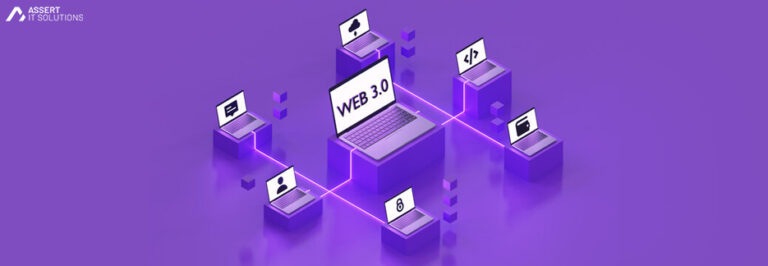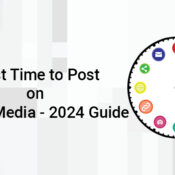
06/11/2022
/
What does Web 3.0 Mean for Social Media
Centering the innovation, creation and growth, the tech industry buzzes with a multitude of opportunities. To top it all, we have the highly engaging social media that reign the market for being exceptionally user-oriented and hyperintelligent.
A Little about the Emergence
Before diving into Web 3.0, let’s see when the roots of Web 3.0 were laid.
 Laying the foundation of the future, technological evolution demands transparency, agility, collaboration, sustainability, and digital innovation.
Let’s take Social media into account for instance; Social media is entirely a Web 2.0 evolution that focuses on spurring the growth of human connection, interaction and businesses. Web 2.0 centres around accessible platforms that stimulated content creation by users. The enhanced web-based sharing has been the cornerstone of the journey. People started to use Facebook, Twitter and other platforms to share everything important or interesting, which was earlier done via emails. Encouraging single-click sharing, user-generated content, and improved accessibility, Web 2.0 turned into a successful experiment. However, its dimensions were not limited to social media; the user-centric web was the demand for Interactive websites and blogs and has disrupted certain industries tremendously. Your smartphone is a living example of this disruption.
While the centralized social media 2.0 is prominent, the web 3.0 outwits by being decentralized and community-oriented. This makes the users part-owners to hold equal value in decision making, operations and governance. With power transferred to the hands of the users, the change will be radically acceptable.
Laying the foundation of the future, technological evolution demands transparency, agility, collaboration, sustainability, and digital innovation.
Let’s take Social media into account for instance; Social media is entirely a Web 2.0 evolution that focuses on spurring the growth of human connection, interaction and businesses. Web 2.0 centres around accessible platforms that stimulated content creation by users. The enhanced web-based sharing has been the cornerstone of the journey. People started to use Facebook, Twitter and other platforms to share everything important or interesting, which was earlier done via emails. Encouraging single-click sharing, user-generated content, and improved accessibility, Web 2.0 turned into a successful experiment. However, its dimensions were not limited to social media; the user-centric web was the demand for Interactive websites and blogs and has disrupted certain industries tremendously. Your smartphone is a living example of this disruption.
While the centralized social media 2.0 is prominent, the web 3.0 outwits by being decentralized and community-oriented. This makes the users part-owners to hold equal value in decision making, operations and governance. With power transferred to the hands of the users, the change will be radically acceptable.
 Since the use of social media is so intense, a minor glitch can turn into an unbearable blunder. Web 3.0 is meant to fix those issues for careful browsing. Big technology companies are starting to get fascinated by the advent of web 3.0 and are on the edge to adopt them. Lately, the social media giant, Twitter announced adding a Web 3.0 feature onto its platform. Businesses are upping the ways to interact, transact and socialize online, be it through social media or websites. If you check the stats, more than 65% of online businesses are running on Instagram, such high is the adoption rate. With NFTs and Metaverse in the market, Web 3.0 is ready to make the cut.
The concerns about data privacy are at their height, but the mechanism is going to reverse soon. The change will make the user's sole owners of their information and data just like NFTs. The semantic web will be entrusted with the role to make sharing of personal information optional for users.
Web 2.0 is known for the mass accumulation of user data, but web 3.0 will replace it to make it a customer-centric user web. No more unwanted, unskippable advertisements and pop-ups. As a social media marketing agency, we have the advantage of analyzing the difference that web 3.0 can make and implementing it for further betterment of social media usage.
Since the use of social media is so intense, a minor glitch can turn into an unbearable blunder. Web 3.0 is meant to fix those issues for careful browsing. Big technology companies are starting to get fascinated by the advent of web 3.0 and are on the edge to adopt them. Lately, the social media giant, Twitter announced adding a Web 3.0 feature onto its platform. Businesses are upping the ways to interact, transact and socialize online, be it through social media or websites. If you check the stats, more than 65% of online businesses are running on Instagram, such high is the adoption rate. With NFTs and Metaverse in the market, Web 3.0 is ready to make the cut.
The concerns about data privacy are at their height, but the mechanism is going to reverse soon. The change will make the user's sole owners of their information and data just like NFTs. The semantic web will be entrusted with the role to make sharing of personal information optional for users.
Web 2.0 is known for the mass accumulation of user data, but web 3.0 will replace it to make it a customer-centric user web. No more unwanted, unskippable advertisements and pop-ups. As a social media marketing agency, we have the advantage of analyzing the difference that web 3.0 can make and implementing it for further betterment of social media usage.
 However, with advantages comes disadvantages, and there are potential disadvantages of Web 3.0 for Social Media that should be learned beforehand.
However, with advantages comes disadvantages, and there are potential disadvantages of Web 3.0 for Social Media that should be learned beforehand.
- Web 1.0 (the 1990s and early 2000s) refers to the earliest version of the internet when one-way communication ruled. Remember those “read-only” web days, which were less interactive and more informational?
- Web 2.0 (current version) of the internet invited the business models to be web-based and toggled innovations through smartphones, mobile internet access, and social networks etc.
- Besides, Web 3.0 is yet to come; its footsteps can be traced to the adaption of enhanced Decentralization, Permissionlessness and Trustlessness, Connectivity and Ubiquity, Machine Learning, Data Sciences, and Artificial Intelligence (AI). Web 3.0 is a quagmire of digital technologies such as AI, data sciences, ML, cloud and big data.
The Connection between Social Media and Web 2.0
 Laying the foundation of the future, technological evolution demands transparency, agility, collaboration, sustainability, and digital innovation.
Let’s take Social media into account for instance; Social media is entirely a Web 2.0 evolution that focuses on spurring the growth of human connection, interaction and businesses. Web 2.0 centres around accessible platforms that stimulated content creation by users. The enhanced web-based sharing has been the cornerstone of the journey. People started to use Facebook, Twitter and other platforms to share everything important or interesting, which was earlier done via emails. Encouraging single-click sharing, user-generated content, and improved accessibility, Web 2.0 turned into a successful experiment. However, its dimensions were not limited to social media; the user-centric web was the demand for Interactive websites and blogs and has disrupted certain industries tremendously. Your smartphone is a living example of this disruption.
While the centralized social media 2.0 is prominent, the web 3.0 outwits by being decentralized and community-oriented. This makes the users part-owners to hold equal value in decision making, operations and governance. With power transferred to the hands of the users, the change will be radically acceptable.
Laying the foundation of the future, technological evolution demands transparency, agility, collaboration, sustainability, and digital innovation.
Let’s take Social media into account for instance; Social media is entirely a Web 2.0 evolution that focuses on spurring the growth of human connection, interaction and businesses. Web 2.0 centres around accessible platforms that stimulated content creation by users. The enhanced web-based sharing has been the cornerstone of the journey. People started to use Facebook, Twitter and other platforms to share everything important or interesting, which was earlier done via emails. Encouraging single-click sharing, user-generated content, and improved accessibility, Web 2.0 turned into a successful experiment. However, its dimensions were not limited to social media; the user-centric web was the demand for Interactive websites and blogs and has disrupted certain industries tremendously. Your smartphone is a living example of this disruption.
While the centralized social media 2.0 is prominent, the web 3.0 outwits by being decentralized and community-oriented. This makes the users part-owners to hold equal value in decision making, operations and governance. With power transferred to the hands of the users, the change will be radically acceptable.
- The key features of 3.0 are
- Artificial intelligence
- Semantic web
- 3D graphics
- Ubiquity
What is Semantic Web Mean?
Till date, we create user-oriented and user-generated content, but the time has come to elevate the reliability of the information by making it machine-readable. The semantic web is an approach that helps to describe and link web content to make it meaningful to machines. It simplifies the human and machine interaction for Trustless data transfers, easy ownership transfers, automatization, and cryptocurrency-based payments. The semantic Web is an extension of the existing Web. It caters programs with machine-interpretable metadata of the published information and data. With the Semantic web, possibilities for decentralized data marketplaces, decentralized autonomous organizations (DAOs), self-sovereign identities, and global-scale decentralized autonomous companies (DACs) will usher, eventually.How Web 3.0 will Change the World of Social Media?
 Since the use of social media is so intense, a minor glitch can turn into an unbearable blunder. Web 3.0 is meant to fix those issues for careful browsing. Big technology companies are starting to get fascinated by the advent of web 3.0 and are on the edge to adopt them. Lately, the social media giant, Twitter announced adding a Web 3.0 feature onto its platform. Businesses are upping the ways to interact, transact and socialize online, be it through social media or websites. If you check the stats, more than 65% of online businesses are running on Instagram, such high is the adoption rate. With NFTs and Metaverse in the market, Web 3.0 is ready to make the cut.
The concerns about data privacy are at their height, but the mechanism is going to reverse soon. The change will make the user's sole owners of their information and data just like NFTs. The semantic web will be entrusted with the role to make sharing of personal information optional for users.
Web 2.0 is known for the mass accumulation of user data, but web 3.0 will replace it to make it a customer-centric user web. No more unwanted, unskippable advertisements and pop-ups. As a social media marketing agency, we have the advantage of analyzing the difference that web 3.0 can make and implementing it for further betterment of social media usage.
Since the use of social media is so intense, a minor glitch can turn into an unbearable blunder. Web 3.0 is meant to fix those issues for careful browsing. Big technology companies are starting to get fascinated by the advent of web 3.0 and are on the edge to adopt them. Lately, the social media giant, Twitter announced adding a Web 3.0 feature onto its platform. Businesses are upping the ways to interact, transact and socialize online, be it through social media or websites. If you check the stats, more than 65% of online businesses are running on Instagram, such high is the adoption rate. With NFTs and Metaverse in the market, Web 3.0 is ready to make the cut.
The concerns about data privacy are at their height, but the mechanism is going to reverse soon. The change will make the user's sole owners of their information and data just like NFTs. The semantic web will be entrusted with the role to make sharing of personal information optional for users.
Web 2.0 is known for the mass accumulation of user data, but web 3.0 will replace it to make it a customer-centric user web. No more unwanted, unskippable advertisements and pop-ups. As a social media marketing agency, we have the advantage of analyzing the difference that web 3.0 can make and implementing it for further betterment of social media usage.
Disadvantages of Web 3.0
 However, with advantages comes disadvantages, and there are potential disadvantages of Web 3.0 for Social Media that should be learned beforehand.
However, with advantages comes disadvantages, and there are potential disadvantages of Web 3.0 for Social Media that should be learned beforehand.
- It requires users to upskill in order to use a decentralized online ecosystem based on blockchain.
- Some of the technologies are quite intricate for beginners to regulate.
- Failing to use it properly will give rise to cybercrimes.
- Since Web 3.0 is huge and interconnected, the personal and public data of users will become highly available.
Conclusion
Web 3.0 is decentralized, transparent, and trustable as it is based on blockchain- known for its highest security standards. There are always some loopholes in technology that are needed to be fixed to avoid mishaps or crimes and can only be achieved after mastering the technology.Recent Posts
Monika Narriya/0 Comments
Why are ERP solutions important in the education sector?
Monika Narriya/0 Comments
Which is the best ERP solution provider company?
Monika Narriya/0 Comments
How do we select the right ERP solution for our businesses?
Sumit Kumar/0 Comments
9 Most In-Demand Programming Languages for 2024
Sumit Kumar/0 Comments
Best Time to Post on Social Media – 2024 Guide
Sumit Kumar/0 Comments
Why You Should Consider Semantic HTML for SEO
All Categories
- Bing
- Blockchain
- Blog
- Branding
- Case Study
- Content Marketing
- Conversion Rate Optimization
- Cryptocurrency
- Digital Currency
- Digital Marketing
- Email Marketing
- ERP Solutions
- Facebook Marketing
- Google Ads
- Google Updates
- Graphic Designing
- Hire Developers
- Image SEO
- Influencer Marketing
- IT
- Local SEO
- Machine Learning
- Mobile Application Development
- Pay Per Click
- Pinterest SEO
- Podcast Hosting
- React JS
- Reddit & Quora
- Search Engine Optimization
- SEO Copywriting
- Social Media Marketing
- Software
- Software Development
- Technology
- UX and UI
- Web Designs
- Web Hosting
- Website Development
- Website Redesigning
- YouTube SEO








